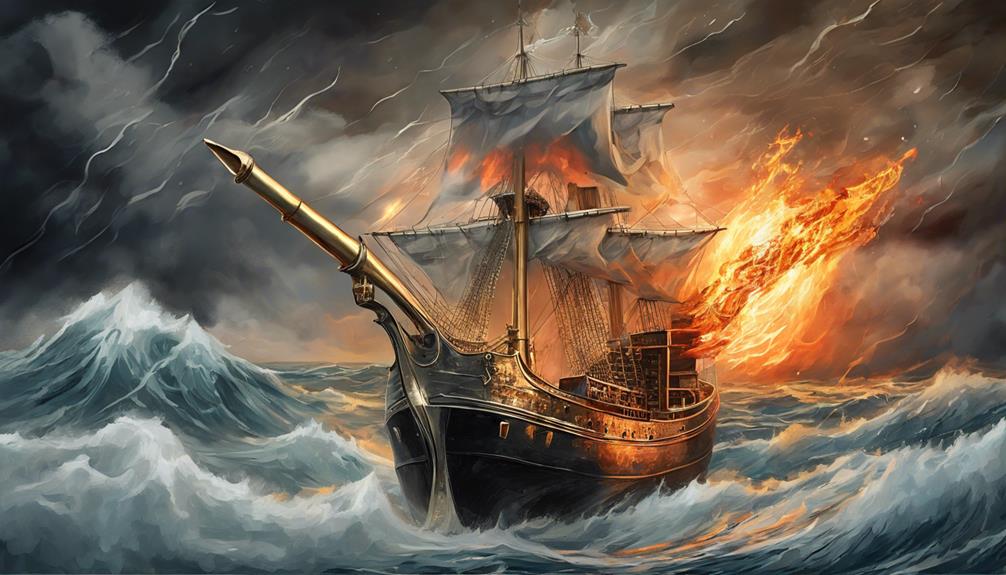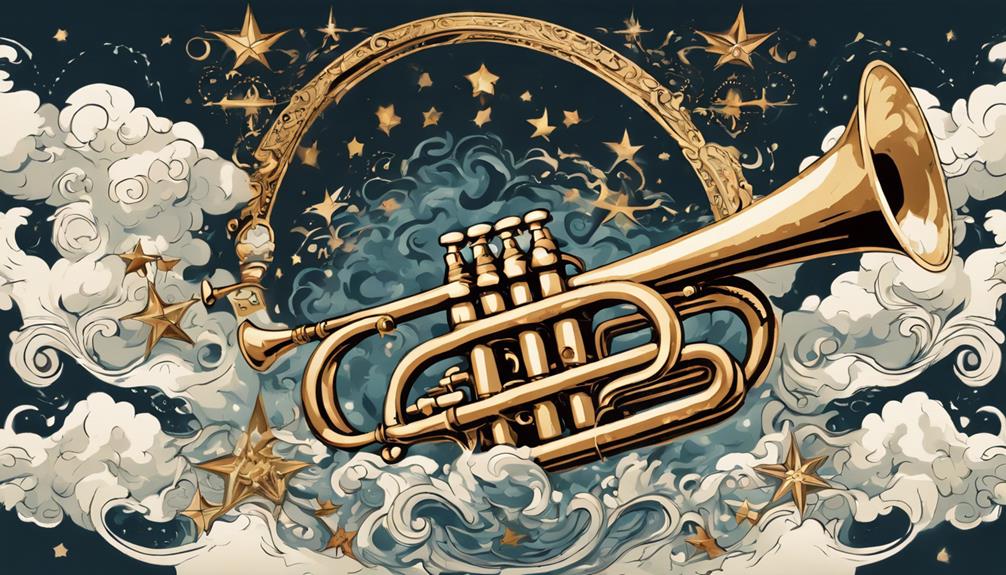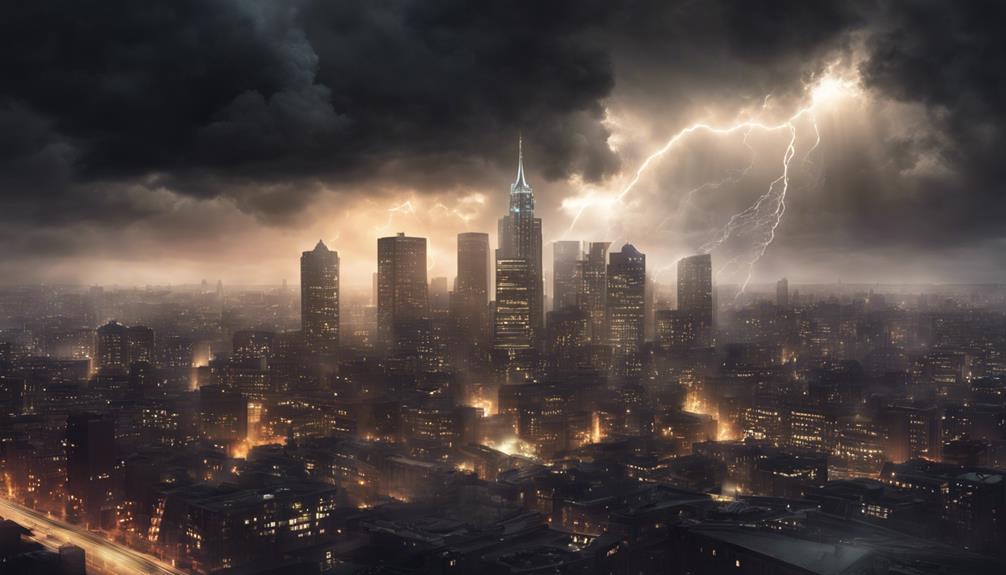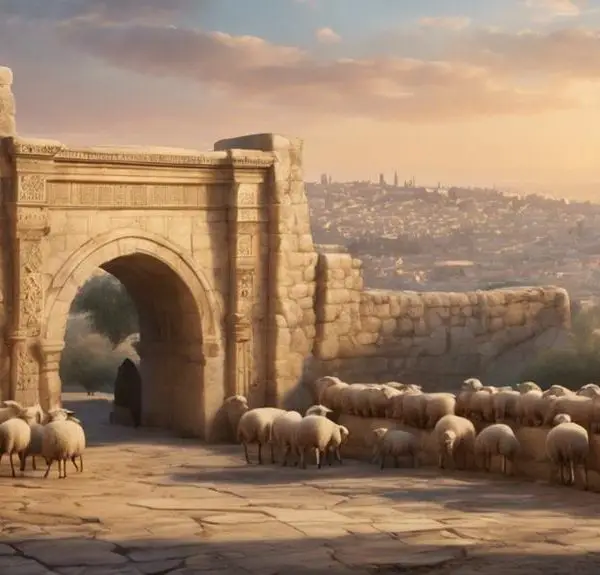Harbinger of cataclysm, the Second Trumpet in Revelation unveils a tale of divine judgment and mystery, beckoning deeper exploration into its ominous warning.

What Is the Second Trumpet in the Bible
As you navigate the complexities of the Book of Revelation, the second trumpet blasts like a clarion call amidst the silence, signaling events that are both intriguing and bewildering. This trumpet, detailed in Revelation 8:8-9, introduces a narrative filled with symbolism and apocalyptic imagery that has puzzled scholars and theologians alike for centuries.
You'll find that understanding its significance isn't just about unraveling ancient texts; it's about connecting these revelations to broader historical and contemporary themes. The implications of this passage extend far beyond its immediate context, touching on aspects of human nature, divine judgment, and the ever-relevant question of the end of times.
Why this matters in today's world might just surprise you.
Key Takeaways
- The Second Trumpet symbolizes divine intervention through catastrophic events and environmental devastation.
- It serves as a theological warning, highlighting the consequences of sin and the need for repentance.
- Its imagery and effects underscore the importance of spiritual preparedness and reflection on divine justice.
- The trumpet's relevance extends to contemporary issues, drawing parallels with modern ecological disasters and global conflicts.
The Biblical Context

To fully grasp the significance of the Second Trumpet in the Bible, it's essential to delve into its surrounding biblical context. The biblical narrative is rich with ancient prophecies, which serve as a foundation for understanding the events described in the Book of Revelation. Specifically, the concept of trumpets plays a pivotal role throughout the scriptures, signaling divine intervention, judgment, or a call to attention. The origins of the trumpet in biblical times were deeply rooted in religious and ceremonial practices.
These instruments weren't merely for musical accompaniment but were integral to the communication of divine messages and the orchestration of communal life. In the context of Revelation, trumpets acquire a symbolic significance, heralding the unfolding of prophetic events. Each trumpet blast corresponds to specific prophetic actions that unfold in the narrative, illustrating a cosmic drama of judgment and redemption. Analyzing the Second Trumpet, therefore, requires an understanding of its predecessors in ancient texts and its role within a broader eschatological framework. This analysis reveals the intricate tapestry of prophecy and symbolism that defines the biblical account of the end times.
The Second Trumpet Explained

Having established the biblical foundation and the significance of trumpets in prophecy, let's explore the specifics of the Second Trumpet as described in the Book of Revelation. When the second of the seven trumpets sounds, it heralds a series of catastrophic events, each symbolized by vivid, apocalyptic imagery that has intrigued scholars and theologians for centuries. The description of the Second Trumpet is particularly evocative, painting a picture of destruction that impacts both the sea and the creatures living within it.
- A great mountain burning with fire: This imagery suggests a cataclysmic event, possibly a volcanic eruption or a meteor strike, that has dire consequences for the earth.
- Thrown into the sea: The impact on the water body signifies widespread devastation, affecting marine life and possibly human settlements near the coast.
- A third of the sea turned to blood: This transformation symbolizes death and destruction, impacting the very essence of life in the sea.
- A third of the living creatures in the sea died: The loss of marine life points to an ecological disaster of significant proportions.
- A third of the ships were destroyed: This indicates disruption in human activities, trade, and communication, highlighting the far-reaching effects of the cataclysm.
The Second Trumpet's sounds introduce a foreboding scenario, replete with apocalyptic imagery that serves as a warning and a call to reflection.
Symbolism and Interpretation

Numerous interpretations exist regarding the symbolism of the Second Trumpet in the Bible, each offering a unique lens through which to view its profound implications. The use of musical symbolism, specifically through the trumpet, isn't arbitrary but deeply rooted in biblical tradition, signifying not only a call to attention but also heralding significant divine actions. The apocalyptic imagery associated with the Second Trumpet—often depicted as cataclysmic environmental disasters—serves to underscore the magnitude of the event it announces, intertwining the physical and spiritual realms in a display of power that transcends human understanding.
Scholars delve into these symbols to unravel the layers of meaning within the text, analyzing how the trumpet's blast heralds a period of judgment and transformation. This apocalyptic imagery, rich with both foreboding and promise, invites readers to reflect on the transient nature of earthly existence and the eternal significance of spiritual readiness. The interpretation of these symbols isn't fixed but evolves with ongoing theological discourse, offering fresh insights into the enduring human quest for understanding in the face of the divine mystery. Thus, the Second Trumpet's symbolism transcends its biblical context, speaking to universal themes of warning, judgment, and the possibility of renewal.
Historical and Theological Impact

The historical and theological impact of the Second Trumpet has profoundly shaped Christian eschatology, echoing through centuries as scholars and theologians grapple with its implications. This event in apocalyptic literature isn't just a moment of prophecy; it's a cornerstone that has influenced countless discussions, debates, and teachings on the end times. The Second Trumpet's resonance is far-reaching, touching on aspects of cultural significance and providing a lens through which many view the potential future events foretold in the Bible.
- Visions of a burning mountain plunging into the sea, devastating a third of the world's waters.
- The haunting imagery of marine life and ships destroyed, symbolizing divine judgment and the fragility of human constructs.
- The interplay between natural disaster and divine intervention, challenging believers and skeptics alike to ponder the boundaries of faith and reason.
- Scholarly debates over the literal versus metaphorical interpretation, reflecting the diverse perspectives within Christian thought.
- The role of the Second Trumpet in shaping apocalyptic narratives, contributing to a rich tapestry of cultural significance in religious and secular contexts alike.
Analyzing the Second Trumpet's place in apocalyptic literature reveals its complex role in shaping theological discourse and cultural narratives about the end times.
Contemporary Relevance

In today's rapidly evolving world, the Second Trumpet's themes of cataclysm and divine judgment remain strikingly relevant, compelling us to re-examine its significance in contemporary theological and moral debates. You'll find that the ancient narrative speaks volumes about the challenges we face today, urging a thoughtful reflection on our actions and their potential consequences.
Aspect |
Relevance |
|---|---|
Environmental Crisis |
Echoes of the Second Trumpet in modern-day ecological disasters. |
Global Conflicts |
Parallels with widespread strife and the quest for peace and justice. |
Moral and Ethical Decay |
A mirror to societal implications of declining moral standards and ethical dilemmas. |
This table delineates the modern parallels and societal implications of the Second Trumpet, underscoring how ancient prophetic visions can shed light on current global issues. The environmental crises we witness today, from rampant pollution to climate change, bear a resemblance to the cataclysmic events described. Similarly, the ongoing global conflicts and moral dilemmas facing society prompt us to ponder the notion of divine judgment and the call for repentance and ethical conduct. Analyzing these connections encourages a deeper understanding of the Second Trumpet's message and its enduring relevance in guiding contemporary thought and action.
Frequently Asked Questions
How Does the Imagery of the Second Trumpet Compare to Similar Apocalyptic Symbols Found in Other Religious Texts Outside of Christianity?
Examining apocalyptic symbols, you'll find the imagery associated with the second trumpet shares thematic parallels with Hindu and Islamic eschatology. These traditions depict cataclysmic events signaling the end of times with vivid, often terrifying imagery.
In Hindu eschatology, cosmic dissolution precedes renewal, while Islamic texts describe a series of trumpets announcing judgment day. This comparison reveals a common thread across cultures: a transformative upheaval marking the transition to a new era.
In What Ways Have Various Artistic Representations (Paintings, Literature, Music) Been Influenced by the Description of the Second Trumpet in Revelation?
You've likely seen or heard artistic interpretations influenced by the second trumpet in Revelation, from musical compositions to paintings. These works often integrate artistic symbolism, depicting chaos and divine judgement with vivid imagery.
Composers and artists delve into these themes, using them to evoke strong emotional responses. This apocalyptic vision has inspired art across centuries, reflecting society's fascination with end-times narratives and their symbolic representation of moral and existential dilemmas.
Are There Any Documented Psychological Effects on Individuals or Groups That Have Fixated on the Second Trumpet's Imagery and Message?
You're diving into whether there's historical accuracy in reports of psychological effects on people obsessed with the second trumpet's imagery. Studies suggest that intense fixation can impact mental health, leading to anxiety or fear.
Scholars note that the vivid, apocalyptic visuals might trigger these reactions. It's crucial to analyze how historical texts and interpretations influence individual and group psychology, shedding light on the broader implications of religious symbolism on mental wellbeing.
How Have Interpretations of the Second Trumpet Evolved With Advancements in Science and Technology, Especially Concerning Environmental Catastrophes?
You've seen how interpretations of apocalyptic imagery evolve, especially as science and technology advance. With climate change and technological disasters becoming more prevalent, scholars link these modern crises to ancient prophecies. This connection suggests that environmental catastrophes might be the fulfillment of such predictions.
As you delve deeper, you'll notice a shift in understanding, where ancient texts are framed within contemporary environmental and technological contexts, offering a fresh perspective on old warnings.
What Role Has the Second Trumpet Played in Popular Culture, Specifically in Movies, TV Shows, and Novels, and How Has This Influenced Public Perception of Biblical Prophecy?
You've likely noticed how the Second Trumpet myths have woven their way into pop culture, sparking a cultural fascination. From blockbuster movies to gripping novels, this element has colored narratives, influencing how we perceive biblical prophecy.
This trend not only entertains but also shapes our understanding of ancient texts in modern contexts. As a result, it plays a critical role in bridging the gap between historical religious beliefs and contemporary entertainment.
Conclusion
In conclusion, the second trumpet in the Bible symbolizes divine judgment, specifically through environmental catastrophe. Its interpretation, grounded in both historical and theological contexts, underscores the profound impact of human sinfulness on creation.
Scholars have linked this imagery to broader eschatological themes, emphasizing its relevance to contemporary discussions on environmental stewardship and ethical responsibility. Thus, the second trumpet serves as a poignant reminder of the interconnectedness of spirituality, morality, and the natural world, urging a reflective consideration of our ecological footprint.



Sign up